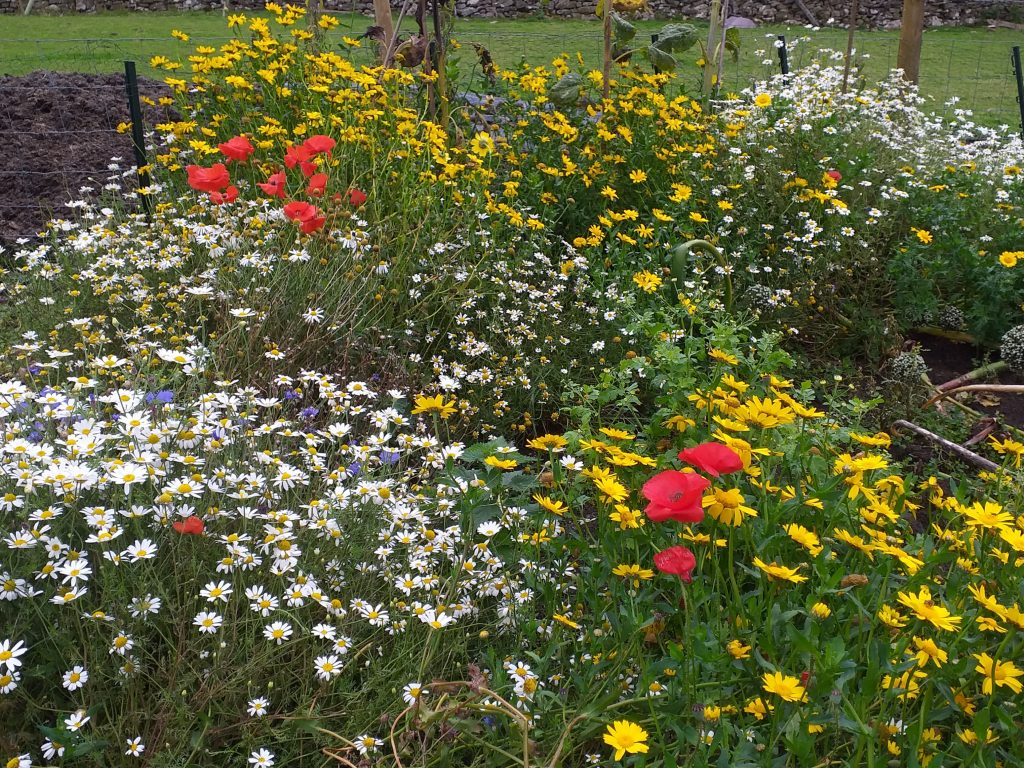
Let’s talk about sex…
Female gametes, male gametes.
Now, if you don’t have your own way of getting one to the other, you’re going to need a bit of help and this is where ‘pollinators’ assist by moving the pollen from the (male) stamen to the (female) stigma resulting in fertilisation of the ovules (female gametes).
Insects are the pollinators of more than 80% of crop species in Europe (1), including most fruits, many vegetables, and some biofuel crops. Pollinators do this because there is something in it for them – usually a food source in the form of nectar or from pollen. Pollen is thereby incidentally moved by sticking to their bodies while they feed to where it is needed for fertilisation to occur. It’s a kind of magic…
When you consider ‘pollinators’ you will almost certainly think of bees and butterflies, but what about wasps, moths, flies, beetles, birds, bats (and of course humans too.) In fact, according to DEFRA there are about 1500 (insect) pollinator species in the UK (2)
Pollinators are essential for crop production, biodiversity/healthy ecosystem and our wider environment. Without pollinators, we would not be able to feed ourselves! Indeed, a true genius said(*) ““If the bee disappears from the surface of the earth, man would have no more than four years to live…No more bees, no more pollination … no more men!” so you’d hope we’d be sitting up, listening and ACTING. This quote is, of course, commonly attributed to Albert Einstein although its provenance is suspect (he died in 1955 and the quote appeared in a 1994 pamphlet distributed by the National Union of French Apiculture). Nevertheless, the general point is undoubtedly well made: we are in serioustrouble if bees and other pollinators become extinct.
The bad news is recent research (3) indicates insect population globally is in decline (the word ‘catastrophic’ is used). Pesticide use as a result of intensive agriculture is cited as a principle cause; other causes include urbanisation/loss of habitat and climate change (although these are all obviously inextricably linked). Honey bee colonies (and therefore the honey bee population) have also collapsed because of varroa mite infection (4)
The big picture is poor and at a ‘macro’ level we need to campaign for example, against the reintroduction of neonicotinoids (currently banned under EU (!!) regulations since the end of 2018 – except in enclosed greenhouses! (5)). These are not only implicated in the decimation of insect population but also songbird populations (6). We can also try to do our bit at the ‘micro’ level as individuals or communities.
My first plea to you is: PLEASE PLEASE do not use insecticides. They might kill what you want dead, but they are indiscriminate – and long lasting. Secondly – and more positively – plant flowers and other plants that attract pollinators (many of whom also eat those pesky pests like greenfly). In particular, think about what you could grow early and late season when food sources are scarcer for bees, hoverflies etc. Even if you only have a small space (or none at all) you can do your bit – for example lavender in a pot at your doorstep. If you have a bigger space, you can be more ambitious – even creating a mini wild flower meadow (7). It is a great time to think about doing this (Autumn) by the way. Do think about ‘under-gardening’. By that I mean don’t keep everything primped, scrupulously weeded, the grass closely cut etc – it’s a lazy gardener’s charter! Seriously though, let the clover, buttercups – and even dandelions – flower (take the heads off the dandelions before they go to seed if you don’t want them to spread). If you have a bigger garden, consider keeping a patch of nettles.
Perennials/shrubs/herbs are great – lavender, hawthorn, honeysuckle, ivy (let it flower – they are an important late nectar source), rosemary, marjoram, chives (and many more). Wildflowers – in addition to those associated with our local hay meadows – include cowslip, white deadnettle, foxglove, comfrey (caution, it’s rampant!), forget-me-not, borage. And let’s not dismiss annuals – many (be careful though, not all) are great pollinators and lovely in their own right: sunflowers, cornflower, poppies, calendula, chamomile, aster, and cosmos. Mixed grasses (again think hay meadows (8)) are excellent for pollinators too. This is intended to whet your appetite and there are much more comprehensive ideas out there – for example see the ideas from the Woodland Trust (9) and Friends of the Earth (10).
Time to get planning, then planting and sowing!
References/ Sources/Further reading
(*) he almost certainly didn’t!
(4) http://www.nationalbeeunit.com/downloadDocument.cfm?id=16
(5) https://www.theguardian.com/environment/2018/apr/27/eu-agrees-total-ban-on-bee-harming-pesticides
(8) https://www.ydmt.org/muker-meadows-swaledale
(9) https://www.woodlandtrust.org.uk/blog/2019/03/wildflowers-for-bees/
(10) https://friendsoftheearth.uk/bees/beefriendly-plants-every-season
Delyth Rennie 10/10/19
This is a thoughtful blog drawing our attention to the importance of supporting pollinators and understanding their role. It is also worth mentioning that here in Swaledale, trees play a major role in pollen and nectar provision. The humble sycamore, for example, is an early-season pollen source, along with the more obvious willow and hazel. It’s prudent to think before you take out a tree, there are lots of smaller trees such as fruit trees that you can plant even in small gardens to add diversity.
Good piece, thank you Delyth. Nicely written and very useful references. Suitably inspired we have just bought some yellow rattle to start on the ‘mini-meadow’ project we’ve been talking about all year. ‘Undergardening’ is a great term!
A plant that never seems to get a mention but is a favourite of the bumblebees , honey and solitary bees in my garden is Green Alkanet.
It flowers over a long period of time and despite being in the shade of trees always has bees.
It does have a tendency to spread but as the bees like it so much I let it grow. It looks good with Foxgloves and the rabbits don’t eat it !